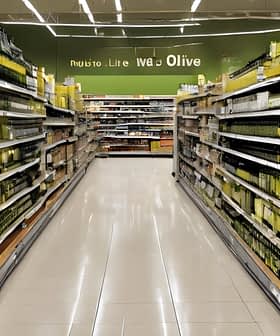Harvest Unfolds with Mixed Results in Greece
A modest yield is expected in most of the producing regions of the country, with many producers pinning their hopes on quality.
Olives harvesting is in full swing in Greece, with the outcome so far verifying the initial projections of a reduced national olive oil yield, slightly exceeding 200,000 tons.
As the majority of producing territories have been shaken by the erratic weather of last spring and summer, the information provided by producers and mill owners shows that the harvest has become dependent on the weather conditions as never before in recent years.
The main reason for the reduced crop is the reduced blossoming of the olive trees which were impacted by the unnaturally warm weather of last spring.
On Crete, where a mid-range production of around 70,000 tons is expected, producers have come to terms with the fact that the elements have the upper hand this season.
See Also:2021 Harvest Updates“A moderate harvesting season is ahead for the whole island,” the owners of the Kydonakis Bros olive oil mill, located south of Heraklion, told Olive Oil Times. “The discrepancies in olive oil production are a consequence of the bizarre weather pattern of the previous months, which disorganized the olive trees.”
“Producers who grow their trees at a relatively high altitude can get substantial quantities of olive oil,” they added. “In the lowlands, the volume of olive oil is reduced and we advise the producers to postpone harvesting until the olives are ripe enough for a good yield.”
On the other hand, they noted that the quality of the season’s fresh olive oils is high.
“In our area, olive oil quality is better than ever, and we have seen many olive oils with acidities ranging from 0.1 to 0.2,” the mill owners said.
“Having also in mind that a mediocre season is usually followed by a prosperous one, all signs show that we are heading toward a ‘ventema’ [bounteous harvest] next year, provided that no surprises occur on the way,” they added.
However, the quality producers south of Heraklion reap is not evident in other parts of the island. Apart from the decrease in the olive oil quantity, the dry weather conditions also took their toll on the high-quality caliber of Cretan olive oil.
“Some fresh olive oils are less aromatic this season,” Nikos Michelakis, the scientific advisor of the association of the olive oil-making municipalities of Crete (SEDIK), told local media in Chania.
“This is due to the prolonged summer drought that dried out many of the olive fruits, which then could not bounce back. So the olive oils produced are not as fine as expected.”
Olive trees in other areas of the country have endured the threatening unseasonable weather, with local producers ahead of a satisfying harvest.
“Twenty days ago we produced early fresh olive oils with yields of six to one, while a few days ago we reached 4.8 to one, even better,” said Spyros Velmahos, a producer from Petalidi in Messinia. “This means that from a sack of olives we got 10.6 kilograms of olive oil. Problems occurred only in areas where the heatwave hit the trees at a bad time, causing the oil content [of the olive fruits] to be reduced.”
Once again, the pattern is not ubiquitous; other producers in the region told Olive Oil Times that the season’s potential is limited mostly due to the reduced fruition of the olive trees.
See Also:Heavy Downpours Dampen Harvest Outlook in Greece“If you pass outside the oil mills these days, there are only a few sacks of olives waiting to be milled,” they said. “There should be many more, but the olive trees were only half-loaded with olives and the season is short. Hopefully, the next one will be better.”
On the island of Lesbos, olive oil production is expected to fare lower than the 10,000 tons initially expected, instead, reaching around 6,000 tons, according to the local office of agriculture and veterinary services. As a result, local producers rely more on quality than quantity this season.
“We expect premium quality,” mill owner Dimitris Soulakis told Olive Oil Times. “However, the volume of the olive oil produced on the island is less than usual. The harvest here used to begin in November and sometimes lasted until April, but now it is going to end much sooner.”
“The overall olive oil production will by no means be even close to the 10,000 or 12,000 tons the island makes in good times,” he added. “The main reason for the reduced crop is the reduced blossoming of the olive trees which were impacted by the unnaturally warm weather of last spring.”
In northern Greece, most olive oil-producing regions appear highly affected by unfavorable weather conditions, with producers speaking of a catastrophic season.
“We were expecting 20 percent of our usual production, but we finally got nothing,” said Dimosthenis Hatzinikolaou, head of the agricultural olive oil association of Makri, in the Evros region.
“Many producers will have to buy olive oil for domestic use,” he added. “The damage was caused by the lack of fruition, the hail and the frost. Our olive oil mill operates only two days a week and the harvest has already been completed.”
A similar pattern exists in other producing areas of northern Greece, including Kavala and the island of Thasos, where olive oil production is halved this season compared to previous crop years.
Meanwhile, the reduced quantity of olive oil has resulted in increased producers’ prices; however, high prices alone are not a sign of a successful season, according to some.
“Prices are very good,” said mill owner Yorgos Roundos from Halkidiki. “We hear about producers selling 15 kilograms of olive oil for €75 to €80. However, what can you do with quality if there is no quantity?”









